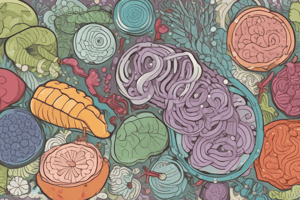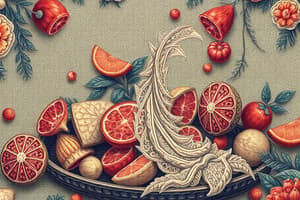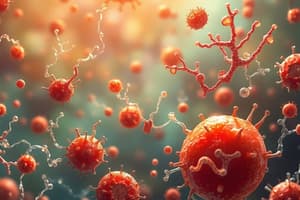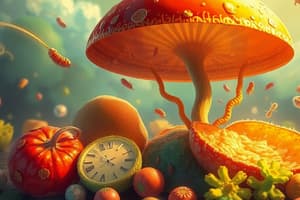Podcast
Questions and Answers
What is the primary definition of food spoilage?
What is the primary definition of food spoilage?
- A change in the texture of food
- The growth of visible mold on the food surface
- A decrease in the nutritional content of food
- A change in the organoleptic properties of food (correct)
Food spoilage always indicates the presence of harmful pathogens that will cause illness if consumed.
Food spoilage always indicates the presence of harmful pathogens that will cause illness if consumed.
False (B)
The production of __________ by microbes contributes to food spoilage.
The production of __________ by microbes contributes to food spoilage.
organic acids
Match each term with its description in the context of food spoilage
Match each term with its description in the context of food spoilage
Which of the following spoilage-related activities is least likely to occur from microbial growth in food?
Which of the following spoilage-related activities is least likely to occur from microbial growth in food?
All microorganisms present in food are considered undesirable; none can contribute to desirable qualities in food.
All microorganisms present in food are considered undesirable; none can contribute to desirable qualities in food.
Provide three ways that physical factors can lead to food spoilage.
Provide three ways that physical factors can lead to food spoilage.
The swelling of food containers is often a sign of gas production by __________.
The swelling of food containers is often a sign of gas production by __________.
Match each foodborne pathogen with its common source:
Match each foodborne pathogen with its common source:
Which pathogen is most associated with improperly canned foods and honey, especially posing a risk to infants?
Which pathogen is most associated with improperly canned foods and honey, especially posing a risk to infants?
In pregnant women, infection with Listeria monocytogenes can only cause fever and muscle aches, with no severe complications.
In pregnant women, infection with Listeria monocytogenes can only cause fever and muscle aches, with no severe complications.
List three illnesses caused by foodborne pathogens.
List three illnesses caused by foodborne pathogens.
Infection with Cyclospora typically presents symptoms about __________ after exposure.
Infection with Cyclospora typically presents symptoms about __________ after exposure.
Match the foodborne illness with its primary symptom:
Match the foodborne illness with its primary symptom:
Which of the following foods is NOT commonly associated with Salmonella contamination?
Which of the following foods is NOT commonly associated with Salmonella contamination?
All strains of E. coli are harmful and cause severe illness when consumed.
All strains of E. coli are harmful and cause severe illness when consumed.
What is the primary risk associated with consuming food contaminated with C. botulinum?
What is the primary risk associated with consuming food contaminated with C. botulinum?
Food pathogens are a __________ of food spoilage organisms that are pathogenic.
Food pathogens are a __________ of food spoilage organisms that are pathogenic.
Match each food with its primary fermenting agent:
Match each food with its primary fermenting agent:
Which of these fermented foods relies on a symbiotic culture of bacteria and yeast for its production?
Which of these fermented foods relies on a symbiotic culture of bacteria and yeast for its production?
Beer is generally lower in alcohol content than wine, and a standard serving of beer contains more alcohol than a standard glass of wine.
Beer is generally lower in alcohol content than wine, and a standard serving of beer contains more alcohol than a standard glass of wine.
Name three fermented foods that depend on the growth of microorganisms for their preservation.
Name three fermented foods that depend on the growth of microorganisms for their preservation.
Vinegar production involves __________ which convert alcohol to acetic acid.
Vinegar production involves __________ which convert alcohol to acetic acid.
Match each fermented food with its defining characteristic:
Match each fermented food with its defining characteristic:
Which fermented food is known for its tangy and sometimes spicy taste, often made with napa cabbage and various spices?
Which fermented food is known for its tangy and sometimes spicy taste, often made with napa cabbage and various spices?
Sauerkraut typically ferments for a shorter period compared to kimchi.
Sauerkraut typically ferments for a shorter period compared to kimchi.
What are the primary ingredients in sauerkraut?
What are the primary ingredients in sauerkraut?
Red wine is known for its high content of __________ which are believed to contribute to heart health.
Red wine is known for its high content of __________ which are believed to contribute to heart health.
Match each fermented food with its culture
Match each fermented food with its culture
Which of the following contributes to the flavor variations in wine?
Which of the following contributes to the flavor variations in wine?
Beer is more like baking where wine is more similar to cooking techniques.
Beer is more like baking where wine is more similar to cooking techniques.
For the symbiotic culture of bacteria and yeast, which food is it most closely associated with?
For the symbiotic culture of bacteria and yeast, which food is it most closely associated with?
________ is defined as a major cause of food waste.
________ is defined as a major cause of food waste.
Match the name with the food item
Match the name with the food item
Which of these spoilage-related activities are most likely from microbial growth in food, particularly the degradation of polymers?
Which of these spoilage-related activities are most likely from microbial growth in food, particularly the degradation of polymers?
All chemical residues that come into contact with food will cause immediate harm or death
All chemical residues that come into contact with food will cause immediate harm or death
Name three chemicals that can negatively impact food quality.
Name three chemicals that can negatively impact food quality.
The formation of __________ can lead to tainting compounds.
The formation of __________ can lead to tainting compounds.
Match each factor with it's physical result.
Match each factor with it's physical result.
Which of the following contribute to potentially psychosomatic reactions after consuming spoilt food?
Which of the following contribute to potentially psychosomatic reactions after consuming spoilt food?
Metabiosis and Pathogenesis are the same principle, just with different nomenclature.
Metabiosis and Pathogenesis are the same principle, just with different nomenclature.
Flashcards
Food spoilage
Food spoilage
Food spoilage is a major cause of food waste.
Spoilage definition
Spoilage definition
Spoilage is defined as a change in the organoleptic properties of a food.
Microbial spoilage products
Microbial spoilage products
Microbes growing on food produce organic acids, esters, carbonyls, diamines, sulfur compounds, hydrocarbons, pigments, colonies and changes in texture.
Food pathogens
Food pathogens
Signup and view all the flashcards
Salmonella spp
Salmonella spp
Signup and view all the flashcards
Listeria monocytogenes
Listeria monocytogenes
Signup and view all the flashcards
Cyclospora
Cyclospora
Signup and view all the flashcards
Campylobacter
Campylobacter
Signup and view all the flashcards
E. coli
E. coli
Signup and view all the flashcards
C. botulinum
C. botulinum
Signup and view all the flashcards
Fermented foods
Fermented foods
Signup and view all the flashcards
Beer
Beer
Signup and view all the flashcards
Wine
Wine
Signup and view all the flashcards
Yogurt
Yogurt
Signup and view all the flashcards
Kefir
Kefir
Signup and view all the flashcards
Vinegar
Vinegar
Signup and view all the flashcards
Sauerkraut
Sauerkraut
Signup and view all the flashcards
Kimchi
Kimchi
Signup and view all the flashcards
Study Notes
- Microorganisms have both desirable and undesirable effects on food
- Food spoilage is a major cause of food waste
Food Spoilage
- Spoilage is a change in the organoleptic properties of food
- Microbes growing on food produce organic acids, esters, carbonyls, diamines, sulfur compounds, hydrocarbons, and pigments
- Microbial growth also results in altered colony appearance and texture of food
Food Pathogens
- Food pathogens are food spoilage organisms causing illness in humans
- Salmonella spp: sourced from vegetables, eggs, chicken, and pork, causes diarrhea, fever, stomach cramps, and vomiting
- Listeria monocytogenes: sourced from unpasteurized milk/dairy, deli meats, and raw fruits/vegetables, can cause stiff neck, confusion, fever, and muscle aches, and can lead to stillbirths in pregnant women if it spreads beyond the gut
- Cyclospora: sourced from raspberries, basil, cilantro, snow peas, and mesclun lettuce (arugula, spinach, Swiss chard, endive, kale, mustards, and lettuces), causes diarrhea, loss of appetite, weight loss, stomach cramps/pain, bloating, increased gas, nausea, and fatigue, symptoms onset roughly one week after infection
- Campylobacter: sourced from unpasteurized milk, chicken, shellfish, turkey, and water, causes diarrhea, cramps, fever, and vomiting
- E. coli: sourced from contaminated food (undercooked beef, milk, and raw fruits/vegetables), causes severe diarrhea and stomach pain
- C. botulinum: sourced from improperly canned goods and honey in infants, causes muscle weakness and blurred vision, and can result in death
Useful Microorganisms in Food
- Fermented foods rely on microbial growth for preservation
- Examples include: Beer, wine, yogurt, kefir, vinegar, sauerkraut and kimchi
Beer
- Beer is brewed from grains (like barley) and hops, and offer a wide range of flavors and it is generally cheaper than wine
- Brewing beer is like cooking, with various ingredients and spices added
- Beer can contain protein, fiber, B vitamins, folate, and niacin, offering a more "food-like" nutritional value than wine
- Beer generally has lower alcohol content than wine, but a standard serving contains about the same alcohol as a standard glass of wine
Wine
- Wine is made from fermented grapes, and have a more acidic/fruity taste, with flavors depending on grape variety, aging, and winemaking techniques
- Red wine contains antioxidants, flavonoids, and tannins that benefit heart health
- Wine typically has a higher alcohol content than beer, and a pint contains 50% more energy than a glass of wine
Yogurt
- Yogurt primarily contains Lactobacillus bulgaricus and Streptococcus thermophilus
- Yogurt is fermented using yogurt starter cultures, typically bacteria
- Yogurt is milder and sweeter than kefir, with a thicker, spoonable consistency and solid
Kefir
- Kefir contains a wider variety of bacteria and yeasts, including Lactobacillus kefiri, Saccharomyces cerevisiae, and Saccharomyces unisporus
- Kefir is fermented using kefir grains, which are a symbiotic culture of bacteria and yeast
- Kefir is tangier and sourer than yogurt, having a thinner and drinkable consistency
Sauerkraut
- Sauerkraut primarily utilizes cabbage, salt, and sometimes caraway seeds, and is typically shredded
- Sauerkraut tends to be more tangy and sour compared to kimchi
- Sauerkraut typically ferments for a longer period than kimchi
Kimchi
- Kimchi uses a wide variety of vegetables (napa cabbage, radishes, cucumbers, etc.) and spices (gochugaru chili powder, garlic, ginger, etc.) and can be served in larger chunks
- Kimberly can be spicy, salty, and tangy, depending on the ingredients and fermentation time
Studying That Suits You
Use AI to generate personalized quizzes and flashcards to suit your learning preferences.




